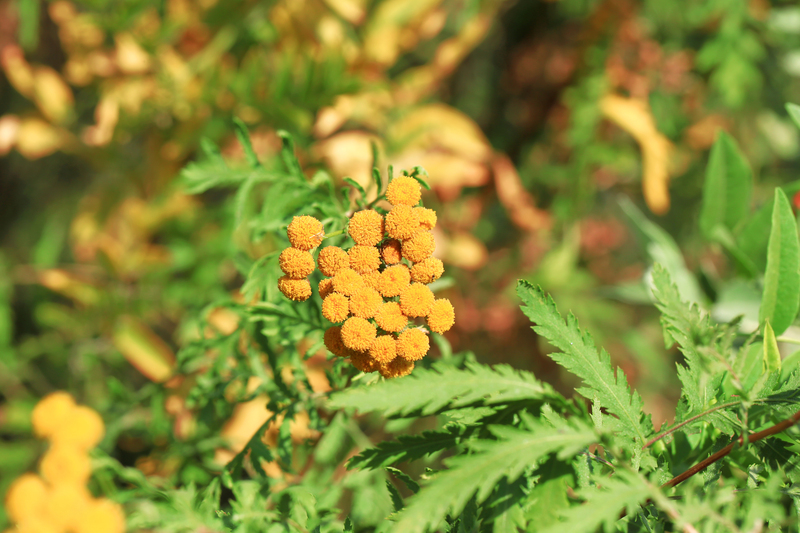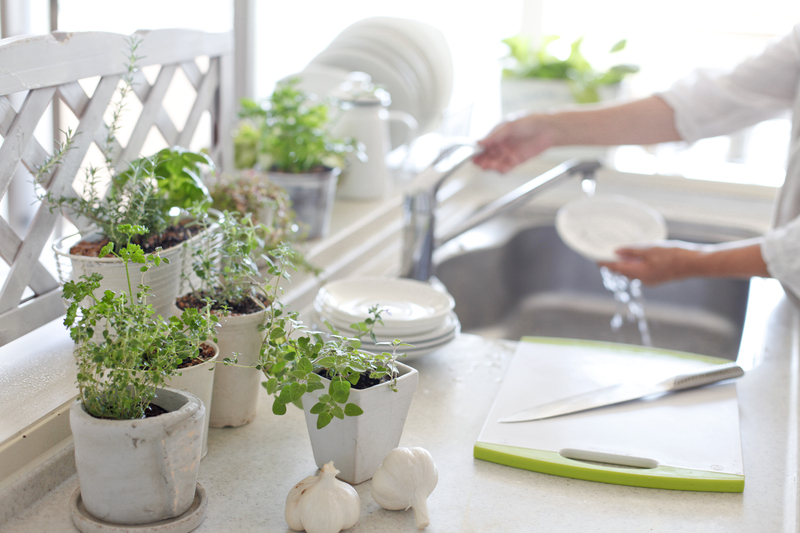Discover the Secrets to Growing a Thriving Herb Garden
Posted on 04/09/2025
Discover the Secrets to Growing a Thriving Herb Garden
If you've ever dreamed of stepping into your backyard and picking fresh basil or rosemary for tonight's dinner, you're not alone. Growing a thriving herb garden at home is a fulfilling experience that blends the joys of gardening, cooking, and wellness. Whether you're a beginner or an experienced gardener, uncovering the secrets to cultivating lush, healthy herbs is well within your reach.
This comprehensive guide will walk you through every aspect of building a successful herb garden. From selecting the right herbs and preparing the ideal soil, to efficient watering routines and organic pest control, you'll discover practical tips and expert insight to help your herb garden flourish all season long.

Why Start a Home Herb Garden?
- Fresh Flavor: Enjoy vibrant flavors and aromas in your dishes, directly from your garden.
- Health Benefits: Many herbs, such as basil, mint, and oregano, are rich in antioxidants and essential nutrients.
- Cost-Effective: Growing your own herbs can help save money compared to buying packaged ones from the store.
- Sustainable Living: Cultivating herbs reduces food waste and your carbon footprint.
- Therapeutic Value: Gardening is a calming, rewarding hobby that benefits mental and physical health.
Choosing the Best Herbs for Your Garden
Selecting the right herbs is the first secret to herb garden success. Consider your climate, space, and culinary preferences. Some popular choices for home herb gardens include:
- Basil - Perfect for Italian dishes and summer salads.
- Rosemary - Hardy, aromatic, and great with roasted meats.
- Mint - A fast-grower, ideal for beverages and desserts. Beware--mint can become invasive if not contained.
- Parsley - Rich in vitamins and highly versatile in world cuisines.
- Thyme - A staple for soups, stews, and roasted vegetables.
- Cilantro (Coriander) - Perfect for Mexican, Indian, and Thai dishes.
- Chives - Easy to grow and delicious in salads and dips.
- Oregano - Must-have for Mediterranean dishes and pizza.
*Perennial vs. Annual Herbs*
Perennial herbs, like rosemary and thyme, return year after year. Annual herbs such as basil and cilantro complete their life cycle in one season. Some, like parsley, are biennials but are often grown as annuals for best yield. Mixing both types ensures a continuous supply throughout the growing season and beyond.
Planning Your Herb Garden Layout
Deciding how and where to grow your herb garden is essential. Herbs thrive in different conditions depending on the species. Follow these tips for best results:
- Sunlight: Most herbs prefer at least 6-8 hours of direct sunlight per day.
- Soil Drainage: Good drainage is non-negotiable; soggy roots mean unhealthy plants.
- Accessibility: Grow herbs close to your kitchen for easy harvesting.
- Container or In-Ground: Many herbs thrive in pots or window boxes, while others are better suited to garden beds.
Design Ideas for Your Herb Patch
- Raised Beds: Improve drainage and control soil quality.
- Spiral Gardens: Allow for microclimates -- place water-loving herbs at the bottom, dry-soil lovers at the top.
- Companion Planting: Grow complementary herbs together, such as basil and tomatoes, to maximize health and flavor.
- Indoor Herb Gardens: Perfect for small spaces. Use sunny windowsills or invest in grow lights.
Secrets to Soil and Nutrient-Rich Growth
Soil Preparation: A Foundation for Success
The secret ingredient in a flourishing herb garden is quality soil. Most herbs do best in loose, well-draining soil rich in organic matter. Here's how to give your plants the best possible start:
- Amend Your Soil: Mix in compost or well-rotted manure to boost fertility.
- pH Preference: Most herbs thrive in a neutral to slightly alkaline soil (pH 6.0-7.5).
- Avoid Heavy Clay: If you have clay soil, lighten it with sand or perlite for better drainage.
- Mulching: Apply an organic mulch to retain moisture, prevent weeds, and add nutrients as it decomposes.
Proper Planting Techniques for Vibrant Herbs
Knowing how to plant your herbs is crucial for a healthy, productive bed.
- Start with Healthy Plants: If growing from seed, provide warmth, light, and consistent moisture for strong germination.
- Spacing: Avoid overcrowding--herbs need space for air flow to prevent diseases. Check plant labels for specifics.
- Group by Needs: Plant herbs with similar requirements together, e.g., Mediterranean herbs like oregano, rosemary, and thyme.
- Transplant Carefully: When moving seedlings outdoors, harden off gradually to prevent shock.
Pro tip:
*Don't forget to label your herbs--many seedlings look similar when young!*
Watering: The Secret Balancing Act
Consistent moisture is vital, but overwatering is a common pitfall in herb gardening. Here's how to strike the right balance:
- Check Soil Moisture: Stick your finger into the soil--water only if the top inch feels dry.
- Morning Watering: Prevents fungal disease and evaporative loss.
- Deep, Infrequent Watering: Encourages robust root systems.
- Mulch Wisely: Helps retain moisture and reduces watering frequency.
Sun and Shade: Meeting Light Requirements
Most culinary herbs crave sunlight, but some prefer a bit of afternoon shade, especially in hot climates.
- Full Sun Lovers: Basil, oregano, thyme, sage, and rosemary.
- Partial Shade Tolerant: Parsley, cilantro, mint, chervil, and lemon balm.
*If growing herbs indoors, place pots near south- or west-facing windows. Use supplemental grow lights in low-light conditions.*
Feeding and Fertilizing for Maximum Flavor
While most herbs are not heavy feeders, providing balanced nutrition ensures consistent growth and the best flavor development.
- Organic Fertilizers: Use fish emulsion or seaweed extract every 4-6 weeks during the growing season.
- Beware of Over-Fertilizing: Excess nutrients can reduce essential oil production, resulting in bland herbs.
- Compost: Top-dress garden beds with a layer of compost each spring.
Pest and Disease Management -- The Natural Way
Keep your herb garden thriving with excellent cultural practices and eco-friendly solutions.
- Encourage Beneficial Insects: Ladybugs, lacewings, and predatory wasps keep pests in check.
- Companion Planting: Marigolds, nasturtiums, and garlic deter many harmful insects.
- Manual Removal: Hand-pick pests such as caterpillars or aphids.
- Neem Oil or Insecticidal Soap: Effective for most soft-bodied insects when used as directed.
- Prevent Disease: Good spacing and air circulation lower the risk of mildew and fungal problems.
Pruning and Harvesting -- The Key to Bushy Herbs
Regular pruning keeps herbs healthy and promotes vigorous growth. Here's how to maximize your harvest:
- Pinch Back Young Plants: Encourages branching for fuller, bushier plants.
- Harvest Early and Often: The more you cut, the more your herbs will grow. Harvest before flowering for best flavor.
- Use Clean, Sharp Shears: Prevents plant damage and the spread of disease.
- Don't Strip Whole Stems: Always leave at least one-third of the plant intact to ensure regrowth.
Tip: Dry or freeze excess herbs for year-round use.
Secrets to Growing Thriving Herbs Indoors
No outdoor space? No problem! With the right approach, you can cultivate a lush indoor herb garden all year.
- Sunlight: Place herbs in the sunniest window or provide dedicated grow lights.
- Quality Potting Mix: Ensure good drainage with a lightweight, organic potting blend.
- Pot Size: Use containers at least 6-8 inches in diameter to give roots room to grow.
- Humidity: Group plants together or use a tray of water with pebbles to increase humidity.
- Rotate Regularly: Turn pots each week for even growth.
Popular indoor herbs include basil, parsley, chives, thyme, and mint.
The Secret to Season Extension
- Cold Frames and Cloches: Protect herbs from frost and extend harvests into the colder months.
- Move Pots Indoors: Transfer tender herbs inside before the first freeze for a continuous supply.
- Grow Under Lights: Keep herbs producing throughout winter with affordable LED grow lamps.
Common Mistakes to Avoid in Your Herb Garden
- Overwatering: Damp soil can quickly rot herb roots. Let the soil dry out between waterings.
- Poor Lighting: Insufficient sunlight leads to leggy, weak plants with poor flavor.
- Neglecting Pruning: Herbs need regular pinching to stay healthy and bushy.
- Ignoring Plant Needs: Some herbs, like mint, require containment; others, like thyme, abhor wet feet.
- Wrong Soil: Heavy or nutrient-depleted soil stunts growth and reduces yields.
Avoid these pitfalls, and your herb garden will thrive impeccably!
Additional Secrets for a Bountiful Herb Garden
- Rotate Crops: Change planting locations each year to prevent pest and disease buildup.
- Use Drip Irrigation: Delivers moisture directly to roots, conserving water and keeping foliage dry.
- Regular Observation: Walk through your garden often to catch issues early and enjoy the progress.
- Keep a Garden Journal: Track what works and what doesn't each season, noting ideal planting dates and harvest times.

How to Use and Store Fresh Herbs
- Fresh Usage: Chop herbs into salads, sauces, marinades, and desserts.
- Drying: Hang bundles in a cool, dry place, or use a dehydrator. Store in airtight containers.
- Freezing: Chop and pack herbs into ice cube trays with olive oil for quick use.
- Herb Infusions: Create oils, vinegars, or syrups for exciting culinary experiments.
Embracing the Joy of Herb Gardening
Growing a thriving herb garden is one of the simplest and most rewarding ways to transform your culinary adventures and create a verdant sanctuary at home. By following these secrets--choosing the best herbs, providing optimal growing environments, nurturing your plants, and using eco-friendly care techniques--you'll unlock the extraordinary power of fresh, homegrown herbs.
Start your herb garden journey today and watch your kitchen and wellbeing flourish!

